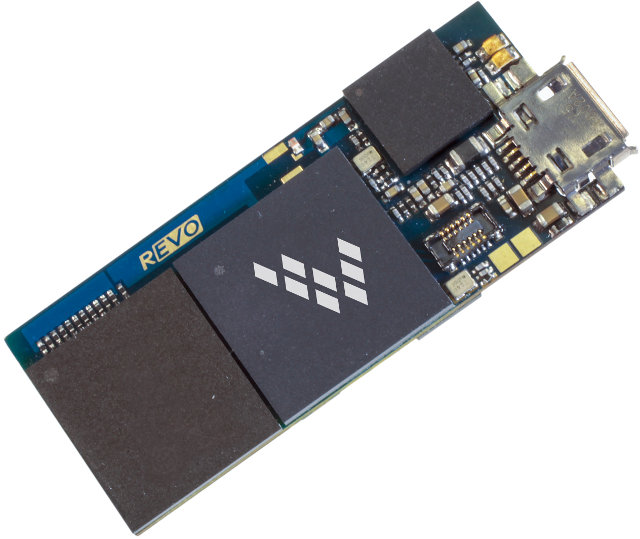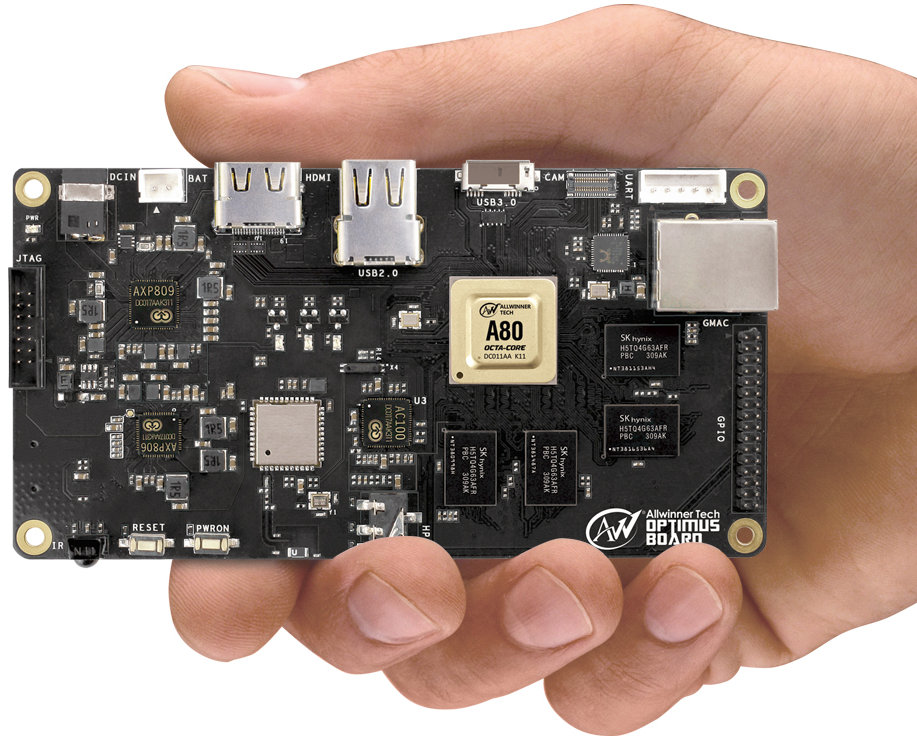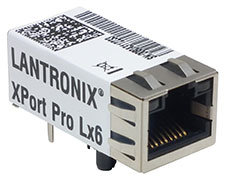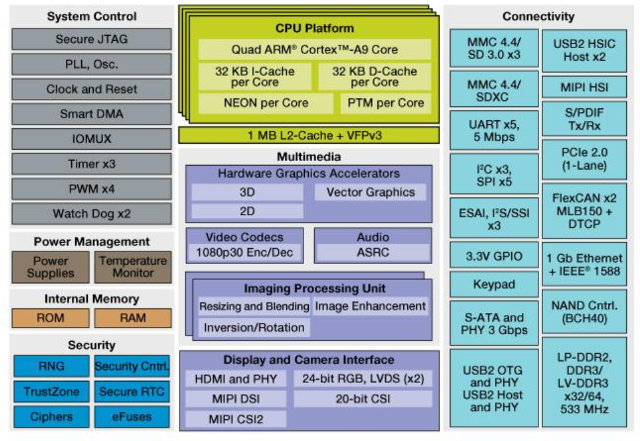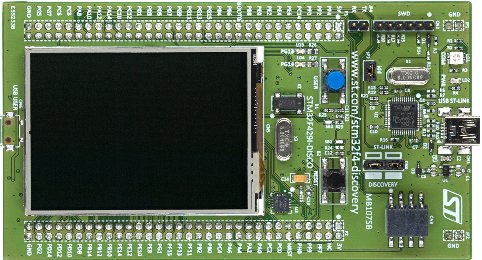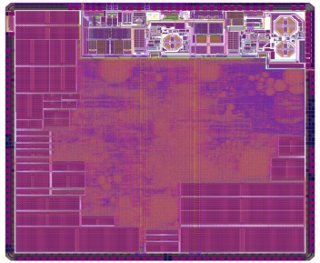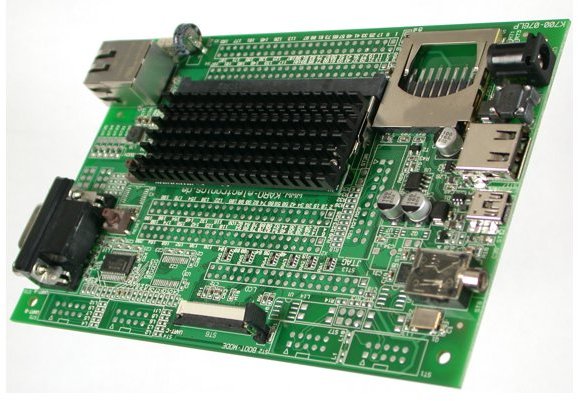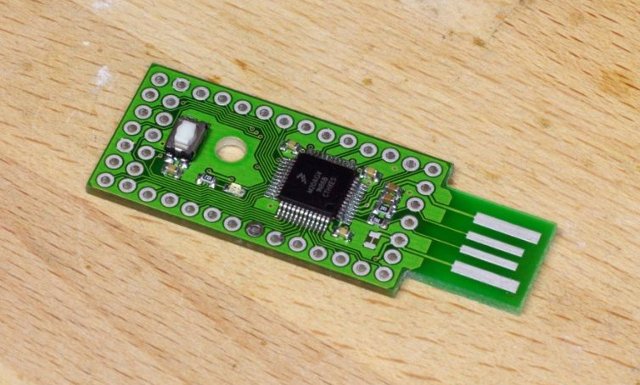We’ve seen more and more wearable products recently, be it smartwaches, smart rings, fitness bands, etc.., and we can expect several announcements at CES 2014 for wearables. Freescale has just launched their Wearable Reference Platform (WaRP), comprised of the WaRPboard, a tiny board based on Freescale i.MX 6SoloLite running Android, and a daughter board with KL16 Cortex M0+ MCU and several sensors. The main chips and corresponding features on the board are as follows: Freescale i.MX 6SoloLite Cortex A9 processor @ 1GHz with 2D graphics Vivante GC355 and GC320 GPUs. KL16 Sub-Family General Purpose Cortex M0+ MCU. Xtrinsic FXOS8700CQ, 6-Axis Sensor with Integrated Linear Accelerometer and Magnetometer. Xtrinsic MMA955xL Intelligent Motion-Sensing Platform. It cane be programmed to provide freefall detection, tilt and 3-D orientation detection, tap and double tap detection, dead reckoning, shock, vibration and sudden motion detection and power management. The company expect WaRP to be used in devices such as […]
What to Expect from AllWinner, Rockchip, Mediatek, and Other Silicon Vendors at CES 2014
CES 2014 is coming soon, and it will take place on 7 – 10 January, 2014, and we can expect some interesting SoC news. Samsung suggested they will unveil their 64-bit ARM SoC (Exynos 6?) at CES 2014, Nvidia will hold a press conference to “showcase new NVIDIA Tegra mobile technologies, gaming innovations, and advanced automotive display technologies”, and Qualcomm has been quiet for now. However, several Chinese SoC vendors, namely AllWinner, Rockchip, and Mediatek, have already announced what they will showcase at CES 2014, albeit with few details. AllWinner at CES 2014 Allwinner announced will showcase their OptimusBoard based on their Ultra Octa-Core A80 SoC, as well as 4G tablets powered by Allwinner A31/A31s, and dual-SIM phablets sporting A23 dual-core. Allwinner A80 is an Octacore processor featuring four ARM Cortex A7 cores, and four Cortex A15 cores @ 2.0GHz together with an unnamed GPU offering 2x more performance over previous […]
Lantronix XPort Pro Lx6 is a Tiny Embedded Linux Server Fitted into an RJ45 Connector
Lantronix has recently launched XPort(R) Pro Lx6, a secure embedded device server supporting IPv6, that barely larger than an RJ45 connector. The device runs Linux or the company’s Evolution OS, and is destined to be used in wired industrial IoT / M2M applications. Lantronix XPort Pro Lx6 Specifications: Processor – Freescale ColdFire MCF5208 up to 166.67 MHz (TBC) 32-bit processor System memory – 16MB SDRAM Storage – 16MB Flash Serial Interface – Software selectable data rates from 300 to 921kbps Programmable IO – 3 PIO pins (software selectable) Network Interface – 10Base-T and 100Base-TX Link with support for IPv4 and IPv6, and the following protocols: TCP/IP, UDP/IP, ARP, ICMP, SNMPv2, TFTP, FTP, Telnet, DHCP, BOOTP, HTTP, SMTP, PPP, AutoIP, RSS, and SYSLOG Security – TCP/AES and UDP/AES Temperature Range – Operating and storage: -40° to +85° C Relative Humidity – 0% to 90% non-condensing Regulatory Approvals – FCC Part 15, Subpart […]
Most Embedded GPUs Do NOT Support Hardware Video Decoding Acceleration. The VPU Does.
Many people seem to get confused with the actual function of GPUs used in embedded (ARM / MIPS) SoC, and I can often read comments similar to “with lima drivers we should get video decoding in XBMc soon”, and I’ve just received any email reading “My main task is to build a full hd media player based on ffmpeg with hardware decoding acceleration for Linux. Is it possible with mali400mp4?”. So I’ve decided to write a short post about it to make things a bit more clear. Contrary to GPUs in the PC world, embedded GPUs only take care of 3D, and sometimes 2D graphics, and leave video encoding and/or decoding to another block called Video Processing Unit (VPU). There’s at least one exception with Broadcom Videocore IV GPU as found in the processor used in the Raspberry Pi that apparently takes care of 2D & 3D graphics as well […]
Free Online Courses & Workshops For ARM Cortex-M Microcontrollers
STMicroelectronics and Digikey are co-sponsoring an EE Times University online training course entitled “Fundamentals of Microcontrollers (MCUs): Hands-On Workshop”. The first two 45-minutes sessions will be theoretical and provide and overview of micro-controllers, and explain methods to select an MCU for a given project. The first 1,000 persons based in the US or Canada, who attended the first 2 sessions, will receive a free STM32F4 Discovery Board (ARM Cortex M4). The three next sessions, conveniently taking place about a week later, hopefully after you’ve received your board, will be an actual workshop with STM32F429 Discovery Board. Here’s the detailed schedule for the training: December 2, 2013, 12PM (Eastern Time) – Session 1 – Introduction to Microcontrollers Common microcontroller architectures Pipelining Peripherals: Timers, Communication, Analog December 3, 2013, 12PM (Eastern Time) – Session 2 – Selecting the Right Microcontroller 10 Steps to Selecting a microcontroller What to look for in a […]
Weightless Roadmap – Silicon, Modules, SDKs, Base Stations and Networks
The Weightless Standard aims at using the “white space” spectrum, previously used by analog TV broadcasts, for free M2M / IoT communication coupled with low power and cost-efficient hardware offering a range of over 10 km. Longer term the target is to reach $2 hardware cost, and $2 yearly servicing costs. Companies involved with Weightless include Neul, ARM, CSR and Freescale among others. You can read my previous post about Weightless for a longer overview. The Weightless Special Interest Group (SIG) has recently revealed the hardware roadmap for the new standard, which I’ll summarize below. Weightless Chip Neul Iceni, the first weightless silicon, was officially announced in February 2013. The latest version of the chip taped in May 2013 integrates UHF radio operating between 410 and 790 MHz supporting both TV white space and narrowband operation. It is suitable for low volume production applications. A third generation will be taped […]
$200 Direct Insight Triton-TXEK EvalKit for iMX6 Features Freescale i.MX 6Quad Processor
With Wandboard Quad, SABRE Lite, Nitrogen6X, and UDOO, we already have some choices when it comes to low cost Freescale i.MX 6Quad development platforms. Direct Insight, a British company, has developed another called TRITON-TXEK EvalKit for iMX6 that includes the company’s Triton-TX6Q SoM, for 130 GBP (about $200). TRITON-TXEK for iMX6 Specifications: Specifications listed for the Triton-TXEK evaluation kit include: SoC – Freescale i.MX 6Quad quad core Cortex-A9 @ 1GHz with Vivante GC2000 GPU System Memory – 1GB DDR3 Storage – 128MB NAND flash + SD card slot Display – TFT panel via 40-pin LCD flat cable header Connectivity – 10/100M Ethernet USB – USB 2.0 host + mini USB 2.0 host/device Serial – RS232on D-Sub connector Audio – 3.5mm headphone jack Power Supply – 5V Dimensions – Module: 68mm × 31mm, Baseboard: Who knows… Operating temperature – -20 to 70°C Since the only easily accessible display option is the […]
MC HCK is a $5 ARM Development Board Powered by Freescale K20 MCU
MC HCK (pronounced McHack) is a tiny and cheap development board powered by Freescale K20 MCU (ARM Cortex M4) that can be easily programmed via USB. The board has been designed with KiCad, is fully open source hardware, and it’s supposed to cost as low as $5. The only problem, or main advantage, depending on how you look at it, is that it’s not available for sale (yet), but instead you’ll need to make it yourself. The actual cost of doing so will be well over $5 (About $35), but the BoM cost is about $5, and you can make 5 boards for this price, or about $7 per board. The detailed steps are explained on McHck blog, but they can summarized as follows: Order 10 PCB using the gerber files via services such as Seeedstudio or Iteadstudio Order 5 free samples of Freescale K20 MCU. Select MK20DX128VLF5 part, and […]


